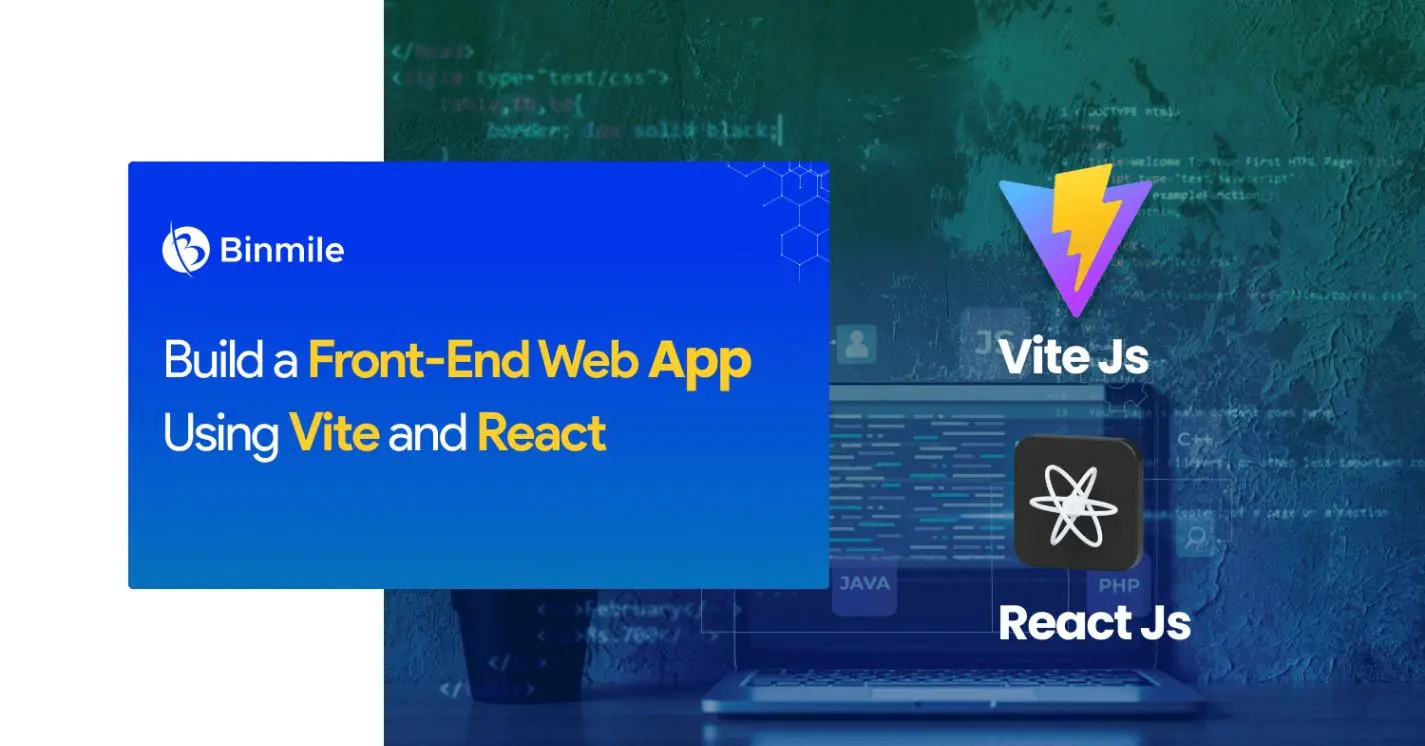- Build A Front-End Web App Using React
- Build A Front-End Web App Using Vite
- Build A Front-End Web App Using Vite And React
- build front end with react
- Create react app with Vite
- front end app vs backend app
- front-end application
- Front-End Development: The Complete Guide
- How Does Front-End Differ From Back-End Application?
- How to Build your React.js App using Vite
- Key Aspects Of Front-End Web Application
- mobile app development services
- react front end
- React.js app development services
- What is React?
- what is vite react
- What is Vite?
Front-end application or an application’s front-end is one of the most critical aspects of the app, incorporating different effects and stylistic preferences to define its visual aspects. A website’s front-end is a daily encounter for a user, in terms of reading or scrolling through headlines or different content on it. You can also call it an interface of an app, allowing users to navigate the application. Therefore, creating a compelling front-end web application is critical for organizations to drive growth in today’s competitive business market. It also indicates the increasing importance of front-end app development services from a reputable mobile app development company.
Key Aspects of Front-End Web Application
- HTML: It is a core foundation for every website on the Internet, enabling page display. Without HTML, an internet browser is clueless about the layout and display of a web page.
- JavaScript: This programming language enables interactive elements for a web page that users engage with directly. It does a dynamic interpretation of each singular piece of code, verifying it in real time to allow a seamless interface process.
- CSS: It ensures full customization of a web page, from layout to style preferences. CSS also ensures proper adjustment and modification of content elements; from font size to spacing, animations, etc.
How Does Front-End Differ From Back-End Application?
| Front-End | Back-End |
| It contains all the necessary visual and interactive elements that users experience directly. | The back-end side of an application is considered its brain and is invisible to the users. |
| Features client-side rendering, server-side rendering, and optimization of CSS, JS, HTML to speed up the app’s performance. | Features databases, API, scripting the framework, architecture, etc. |
| Frameworks include AngularJS, React, vue.js, etc. | Frameworks include Django, Ruby on Rails, CakePHP, Flask, etc. |
PRO TIP: Choose React.js app development services from a trusted development partner to save time and money on your app development processes.
How to Build a Front-End Web App Using Vite and React
In this section of our write-up, we will discuss the steps for creating a front-end web app using Vite and React. However, before we move ahead with our discussion, let’s understand what Vite and React are, their features, and other details.
What is Vite?

Vite is a critical JavaScript build tool, that helps developers build front-end web apps. Created by Evan You, Vite is known to expedite the web application development process because of its inherent features, including Hot Module Replacement (HMR).
Features of Vite:
- Vite’s Hot Module Replacement (HMR) makes an app run faster and more powerful. It enhances an app’s boot-up performance. HMR also simplifies and speeds up the app development process
- It allows users to choose different frameworks as per the suitability of the application
- You can use it to bundle your app or dependencies, modules, and code together for production
What is React?

React or ReactJS or React.js is a JavaScript library or a JS-based UI (user interface) development library. It is not a language but a library featuring various extensions supporting application architecture, such as React Native, and Flux.
Features of React:
- JavaScript Syntax Extension or JSX collectively defines JavaScript and HTML or is an extension to JS programming language syntax. Since JSX is not compatible with browsers, it therefore involves a JS transcompiler known as Babel ensuring backward compatibility of the JavaScript code
- Virtual DOM is another feature of React.js, functioning as a one-way data binding. It checks how new DOM differs from previous DOM representation during modification of a web app which causes re-rendering of the entire UI in virtual DOM representation
- It features one-way data binding, meaning the flow of data in React is in one direction
- The feature of JSX of React simplifies application and coding
- It performs better, thanks to the virtual DOM
PRO TIP: Create a React app with Vite using professional assistance from a reputed software development company.
Building Front-End Web App Using Vite and React
Using React and Vite together can result in the development of fast, interactive and scalable web apps. Here is our rundown on key steps to build a front-end web app using React.js and Vite. However, make sure you’ve installed Node.js and npm package manager on your machine.
If not installed, visit their official website and download them from there.
1: Create a Vite Project
Once done, initiate the process of creating a new Vite project in a new project directory called my-app. Use the Vite command line interface. You will need the following programming command for a new Vite project – npx create-vite-app my-app
2: Create A Development Server

Thereafter, start the development server with the following command. Once created, open the app in your chosen browser on the local host. It will reflect a message, welcoming you to the new Vite+React. A successful installation of React with Vite is when you run the app successfully.
3: Preview The App
Now, you need to preview your newly built app from your phone. For this, you need to expose your app to your local network. Run the app but make sure the current server is not in use. Terminate it using the ctrl+c command. After installing React and importing it at the top of the file, src/main.js – create a React component.
Here’s the code:

The React component bears a message of your choice. To say otherwise, you will render the message as typed in the component. Use the following code –

Remember that once you have used the code, you will get App, the functional component that you have named in the code. Your functional component (App) returns a JSX component that contains a heading you typed in the code. Save the file to see the typed message in your code, like “Hello, Vite + React!” Remember that you will see the same message as typed in the code heading. And this message you will see being displayed in the browser. That’s your Vite+React app.
Winding up
Building a front-end web app using React and Vite will help you save time and money on creating wonderful web apps for your requirements. Though the steps mentioned above are simple to follow, yet you can incorporate the strategies to build more complex projects best suited to your business requirements. Moreover, if you think that you are hard-pressed by time or lack a skilled development team, outsource your app development requirements to skilled IT professionals at Binmile. For more details regarding our web app development services, schedule a call with our experts.
Frequently Asked Questions
Vite React refers to the combination of two technologies: Vite and React. Vite is a build tool that aims to provide a faster and more efficient development experience for web applications, while React is a popular JavaScript library for building user interfaces. When used together, Vite React offers developers a modern and streamlined environment for building React applications.
A React front end refers to the user interface (UI) layer of a web application built using the React JavaScript library. React is a popular open-source library developed by Facebook for building dynamic and interactive user interfaces.
React allows developers to create reusable UI components that represent different parts of a web application’s user interface. These components are composed together to build the overall UI structure. React uses a virtual DOM (Document Object Model) to efficiently render changes to the UI and update only the necessary parts of the page, resulting in improved performance and responsiveness.
Building a front end with React offers several benefits, including:
- Component-Based Architecture: React’s component-based architecture promotes modularity, reusability, and maintainability by breaking down the UI into smaller, self-contained components.
- Virtual DOM: React’s virtual DOM efficiently updates and renders UI components, resulting in improved performance and faster rendering times compared to traditional DOM manipulation.
- Declarative Syntax: React uses a declarative syntax, making it easier to understand and reason about the code. Developers describe how the UI should look based on the application state, rather than imperatively manipulating the DOM.
- Large Ecosystem: React has a large and active ecosystem of libraries, tools, and community support, providing developers with resources and solutions for building robust and scalable front-end applications.
- Cross-Platform Compatibility: With libraries like React Native, developers can use React to build cross-platform mobile applications for iOS and Android, sharing a single codebase.









